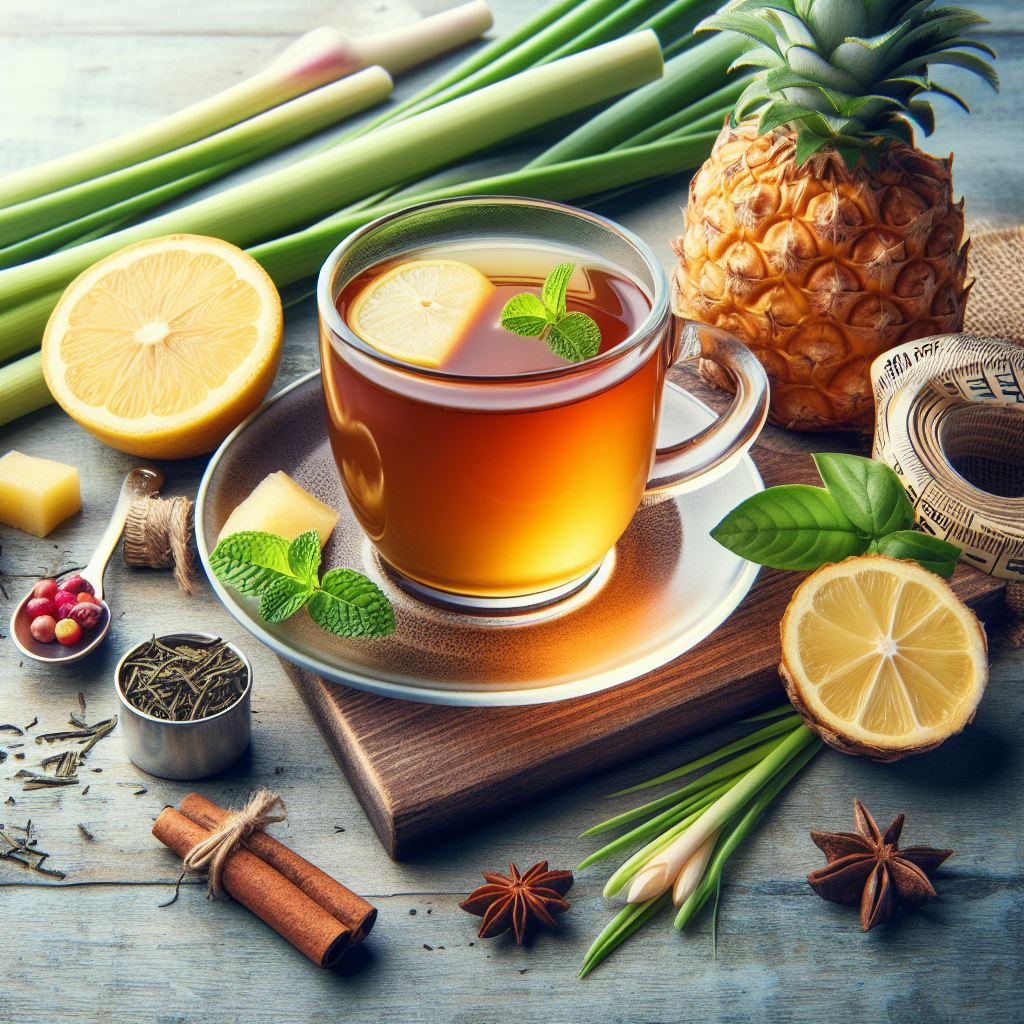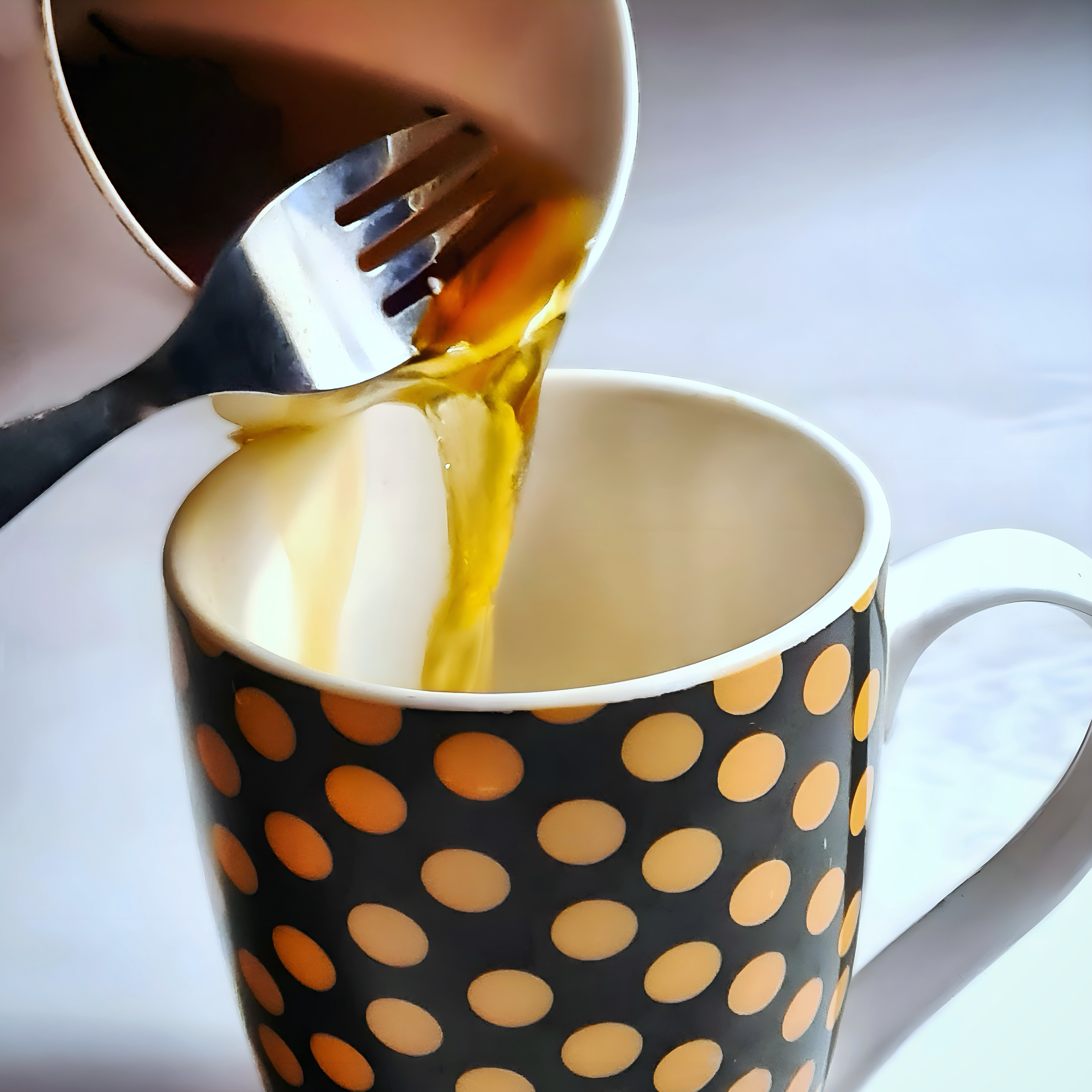Today, we have a special treat: a tea that you may not have heard of before, but trust me, it’s worth a try. It’s made from the silky strands that you usually throw away when you peel a corn cob. Sounds crazy, right? But don’t judge a book by its cover, or a tea by its source. This tea is delicious and healthy, and it has been enjoyed for centuries in various cultures. It’s called corn silk tea, and we will tell you everything you need to know, including:
- What is corn silk and why is it good for you?
- How to make corn silk tea at home?
- How to enjoy corn silk tea in different ways and with different foods?
- What are the health benefits and uses of corn silk tea?
- How to use corn silk tea in creative and unique ways?

What is Corn Silk and Why is it Good for You?
Corn silk is the name given to the long, thin, and shiny fibers that grow on the ears of corn. They are usually yellow or light brown in color, and they have a soft and silky texture. Corn silk is actually the female part of the corn plant, and it serves as the natural pollinator for the corn kernels. It has been used for various purposes since ancient times, such as making textiles, paper, or medicine. Not only that, it is also edible, and it can be used to make a refreshing and nutritious tea!
Not all corns are created equal, though. There are different types of corn, such as sweet corn, field corn, popcorn, or baby corn, and they have different characteristics and uses. For making tea, the best type of corn is sweet corn, which is the most common and widely available variety. Sweet corn has tender and juicy kernels that are rich in sugar and starch (usually eaten as a vegetable/snack). Sweet corn also has the most abundant and flavorful corn silk, which makes it ideal for making tea. You can use fresh or dried corn silk, but fresh corn silk is preferred for its freshness and aroma.
• Health Benefits of Corn Silk
Corn silk is not only tasty, but also healthy. It is rich in antioxidants, such as flavonoids, polyphenols, and saponins. These can protect your cells from oxidative stress and inflammation. Corn silk also contains vitamins, minerals, and amino acids, which can support your overall health and well-being. Some of the health benefits of corn silk include:
- Diuretic: Corn silk can help increase urine output and flush out excess fluids and toxins from your body. This can help prevent or treat urinary tract infections, kidney stones, edema, or high blood pressure.
- Anti-inflammatory: Corn silk can help reduce inflammation and pain in your body, especially in your urinary tract, bladder, or prostate. This can help relieve symptoms of cystitis, prostatitis, or arthritis.
- Antiseptic: Corn silk can help fight against bacteria, fungi, or parasites that can cause infections or diseases in your body. This can help heal wounds, ulcers, or skin irritations.
How to Make Corn Silk Tea at Home?
Now that you know what corn silk is and why it’s good for you, let’s see how you can make your own corn silk tea at home. It’s very simple and easy, and you only need a few ingredients and tools. See below for the steps to follow:

Harvesting and Preparing Corn Silk:
1. Harvest the Corn Silk
The first step is to harvest the corn silk from the corn cobs. The best time to do this is when the corn is ripe and ready to eat. This is usually in late summer or early fall. You can buy fresh corn from your local farmer’s market, grocery store, or even grow your own in your backyard.
To harvest the corn silk, you need to peel back the green husks that cover the corn ears and expose the corn silk. You will see a bunch of silky strands attached to the top of the corn cob. Gently pull them off and collect them in a bowl or a basket. You can use a pair of scissors or a knife to cut them off if they are too hard to pull.
2. Clean the Corn Silk
Once you have harvested the corn silk, you need to clean and dry it before making tea. To clean the corn silk, rinse it under cold running water and remove any dirt, insects, or debris that may be stuck to it. You can also soak it in a bowl of water with some vinegar or lemon juice for a few minutes to disinfect it and remove any pesticides or chemicals that may be present.
3. Dry the Corn Silk
To dry the corn silk, you can either use a dehydrator, an oven, or the sun.
• If you use a dehydrator, spread the corn silk evenly on the trays and set the temperature to low (around 95°F or 35°C). It will take about 6 to 8 hours for the corn silk to dry completely.
• If you use an oven, spread the corn silk on a baking sheet and set the oven to the lowest temperature possible (around 170°F or 75°C). It will take about 2 to 4 hours for the corn silk to dry completely.
• If you use the sun, spread the corn silk on a large cloth or a paper and place it in a sunny and airy spot. It will take about 1 to 2 days for the corn silk to dry completely. You can store the dried corn silk in an airtight container or a ziplock bag for up to a year.
Brewing the Tea:
The second step is to brew the corn silk tea. You can use either fresh or dried corn silk, but the amount and the steeping time will vary. For fresh corn silk, you will need about a handful of corn silk (around 15 grams) for every 4 cups of water (around 1 liter). For dried corn silk, you will need about 2 tablespoons of corn silk (around 10 grams) for every 4 cups of water (around 1 liter).
- To brew the corn silk tea, bring the water to a boil in a large pot or a kettle. Add the corn silk and reduce the heat to low. Simmer the tea for about 10 to 15 minutes for fresh corn silk, or 15 to 20 minutes for dried corn silk. You can also use a teapot or a French press to brew the tea. Just make sure to use a fine mesh strainer or a cheesecloth to filter the tea.
- After the tea is done brewing, strain it and discard the corn silk. You can enjoy the tea hot or cold, plain or sweetened, according to your preference. You can also add some lemon juice, honey, or mint leaves to enhance the flavor and the health benefits of the tea.
How to Enjoy Corn Silk Tea in Different Ways:
Corn silk tea has a unique and pleasant taste that can be described as delicate, mildly sweet, and slightly earthy. It has a light golden color and a subtle aroma that can soothe your senses and relax your mind. One of the many benefits of this tea is its versatility as a beverage that can be enjoyed in different ways and paired with different foods. See below for some variations you could to try:

Change the Tea to Suit Your Needs:
- If you like your tea cold, try it as a refreshing/hydrating drink on a hot summer day. You can also try it as a detoxifying drink to flush out toxins and excess fluids from your body. You can also try making a base for smoothies, juices, or mocktails.
- If you like your tea sweet, add some honey, maple syrup, or agave nectar to give it a natural sweetness. You can also add some stevia, xylitol, or erythritol if you want a low-calorie or sugar-free sweetener.
- If you like your tea sour, add some lemon, lime, or grapefruit juice to give it a tangy and refreshing twist. You can also add some apple cider vinegar, kombucha, or kefir if you want a probiotic and fermented boost.
- If you like your tea minty, add some fresh or dried mint leaves to your corn silk tea to give it a cooling and soothing effect. You can also add some peppermint, spearmint, or lemon balm if you want a different minty flavor.
- If you like your tea spicy, add some ginger, cinnamon, or turmeric to your tea to give it a warming and stimulating kick. You can also add some cardamom, cloves, or nutmeg if you want a more exotic and aromatic spice.
- If you like your tea creamy, add some milk, cream, or coconut milk to your corn silk tea to give it a rich and smooth texture. You can also add some almond, soy, or oat milk if you want a dairy-free or vegan alternative.
- If you like your tea fruity, add some fresh or dried fruits to give it a sweet and juicy flavor. You can also add some berries, apples, or oranges if you want a different fruity flavor.
Health Benefits and Uses
Corn silk tea is not only a delicious and versatile beverage, but also a powerful and natural remedy for various health issues. This tea has been used for centuries in traditional and alternative medicine, and it has proven to be effective and safe for many conditions. Here are some of the health benefits and uses:
• Urinary tract health:
Corn silk tea is one of the best natural remedies for urinary tract infections, or UTIs. This particular tea can help flush out bacteria and toxins from your urinary tract, and prevent them from sticking to the walls of your bladder or urethra. It can also help reduce inflammation and pain in your urinary tract, and soothe any irritation or burning sensation. Additionally, it can help prevent or treat kidney stones, by dissolving and expelling the mineral deposits from your kidneys.
• Digestion:
Corn silk tea can also help improve your digestion and metabolism, by stimulating the production and secretion of bile and digestive enzymes. The tea can help break down fats and carbohydrates, and facilitate their absorption and utilization by your body. It can also help regulate your blood sugar levels, and prevent or manage diabetes. Not only this, it can help relieve constipation, bloating, or gas, by promoting bowel movements and eliminating waste from your colon.
• Skin:
Corn silk tea can also help improve your skin health and appearance, by nourishing and hydrating your skin cells. Drinking this tea can help protect your skin from oxidative stress and inflammation, and prevent or reduce signs of aging, such as wrinkles, sagging, or spots. Moreover, it can help heal wounds, ulcers, or skin irritations, by fighting against bacteria, fungi, or parasites, and by stimulating the regeneration of skin tissue.
Caution:
Corn silk tea is generally safe and well-tolerated by most people. However, it may have some precautions or potential interactions with certain medications or conditions. For example, corn silk tea may lower your blood pressure or blood sugar levels, so you should be careful if you have hypotension or hypoglycemia, or if you are taking any medication for these conditions. Corn silk tea may also increase your urine output or bleeding tendency. This means you should be careful if you have dehydration or a bleeding disorder, or if you are taking any medication for these conditions. If you have any concerns or doubts about drinking corn silk tea, you should consult your healthcare professional before trying it.
What Foods Pair Well with Corn Silk Tea?
Corn silk tea is a wonderful beverage that can be paired with different foods to enhance your tea experience. See below for some food pairings that you can try:

Food Pairings:
- Light pastries: Corn silk tea goes well with light and fluffy pastries, such as croissants, scones, or muffins. The delicate and mildly sweet flavor of the tea balances the buttery and rich taste of the pastries. This creates a harmonious and satisfying combination.
- Fruit-based desserts: Corn silk tea also pairs well with fruit-based desserts, such as pies, tarts, or crumbles. The slightly earthy and refreshing flavor of the tea complements the sweet and tangy taste of the fruits. This creates a contrast and a synergy of flavors.
- Mild cheeses: Corn silk tea can also be enjoyed with mild and soft cheeses, such as brie, camembert, or mozzarella. The smooth and creamy texture of the cheese matches the light and silky texture of the tea. This creates a cozy and comforting sensation.
The Versatility of Corn Silk Tea
Corn silk tea is a wonderful beverage that can be incorporated into your everyday life in many creative and unique ways. This tea is not only a drink, but also an ingredient that can be used in various recipes and applications. See below for some examples of how you can use corn silk tea in your kitchen and beyond:

Try These Alternative Corn Silk-inspired Drinks:
- Iced corn silk tea: You can make a refreshing and hydrating iced corn silk tea by brewing the tea as usual and then chilling it in the fridge or adding some ice cubes. You can also add some lemon juice, honey, or mint leaves to give it a twist. This iced beverage is a great drink for a hot summer day, or for a picnic or a barbecue.
- Corn silk-infused mocktails: You can also make some delicious and fun corn silk-infused mocktails by mixing the tea with some beverages. For example, you can also make a corn silk lemonade by mixing the tea with some lemon juice and sugar, or a corn silk punch by mixing the tea with some fruit juice and sparkling water. Corn silk-infused mocktails are a great drink for a party or a celebration.
- Corn silk soup or broth: You can also use corn silk tea as a base for soups or broths, by adding some vegetables, herbs, spices, or meat to the tea. For example, you can make a corn silk vegetable soup by adding some carrots, celery, onion, garlic, and parsley to the tea, or a corn silk chicken broth by adding some chicken, bay leaf, thyme, and salt to the tea. You can also make a corn silk mushroom soup by adding some mushrooms, cream, and butter, or a corn silk seafood broth by adding some shrimp, clams, mussels, and saffron. Corn silk soup or broth is a great dish for a cold winter day, or for a light and healthy meal.
Conclusion
We hope you enjoyed this blog post about corn silk tea, and that you learned something new and interesting. Hopefully you are curious and excited to try making this healthy tea yourself, and to share your experiences or ask questions in the comments section. We are always happy to hear from you and to answer your queries. Let us know your suggestions and requests for future tea-related content. We have a lot more to share with you about the amazing world of tea, and I promise you more exciting and informative posts in the future. Until then, happy tea drinking!
Discover More Tea-Related Articles:
- Teh Tarik: Malaysian Pulled Tea & How to Make It
- Tea for Anxiety: The Best Natural Remedies For Anxiety
- Lavender Chamomile Tea: How to Make Your Own at Home
- Tea Processing: The Ultimate Journey from Plant to Cup
- Osmanthus Tea: How to Brew, Enjoy, and Use This Floral Delight





Leave a Comment